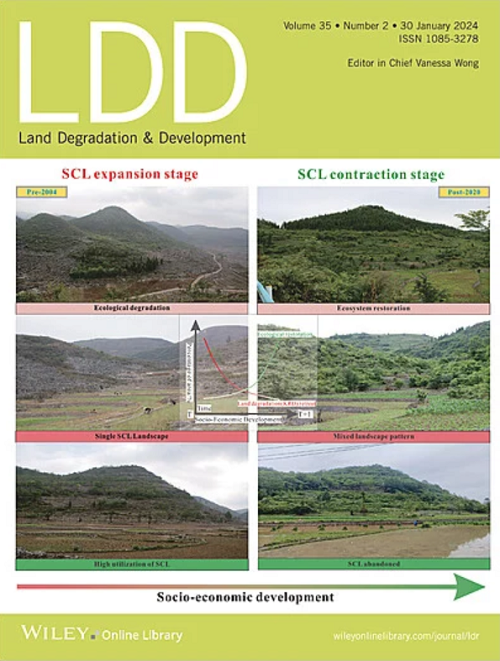Efficiency of Vegetative Filter Strips in Mitigating Soil Erosion and Surface Runoff
IF 3.6
2区 农林科学
Q2 ENVIRONMENTAL SCIENCES
引用次数: 0
Abstract
Vegetative filter strips (VFS) are widely used in agriculture to reduce soil erosion and sediment transport during heavy rainfall events. This study assessed their effectiveness in controlling surface runoff and sediment transport under controlled field conditions. Experiments were conducted on plots of varying lengths (4 and 8 m), slopes (5° and 10°), and vegetation cover (grass, bare soil, and mixed). A suspension of micronized sand and water (40 g·L植物过滤带在减少土壤侵蚀和地表径流中的效果
植物过滤带(VFS)在农业中广泛应用,以减少强降雨条件下的土壤侵蚀和泥沙运移。本研究评估了它们在控制野外条件下控制地表径流和泥沙运移的有效性。实验在不同长度(4和8 m)、坡度(5°和10°)和植被覆盖(草、裸土和混合)的地块上进行。采用40 g·L−1的微粉砂水悬浮液,流速0.5 L·s−1,模拟地表径流。结果证实,植被覆盖显著减少了径流(高达91%)和输沙量(高达98%)。在试验范围内,地块长度对泥沙和径流的减少起主导作用,而坡度的影响最小。裸地径流量和输沙量显著增加,证明了植被在控制侵蚀中的重要性。本研究的一个关键方法学贡献是基于计算方法的VFS效率的分化。采用了两个效率指标:(1)RE(流入与流出的比率)和(2)RE2(与裸土地块的比较)。两种方法间泥沙减少量差异较小(4.7%),径流减少量差异较大(19.9%),凸显了计算方法的影响。此外,VFS优先捕获较粗的沉积物,允许较细的颗粒通过,从而将输送材料的中位粒径(D50)从33 μm降低到6 μm。本研究强调了VFS在减少输沙方面的有效性,强调了植被覆盖和过滤带长度的重要性。它进一步强调,即使只分配了最小的土地面积用于实施,也可以通过方法一致性来优化VFS性能。
本文章由计算机程序翻译,如有差异,请以英文原文为准。
求助全文
约1分钟内获得全文
求助全文
来源期刊

Land Degradation & Development
农林科学-环境科学
CiteScore
7.70
自引率
8.50%
发文量
379
审稿时长
5.5 months
期刊介绍:
Land Degradation & Development is an international journal which seeks to promote rational study of the recognition, monitoring, control and rehabilitation of degradation in terrestrial environments. The journal focuses on:
- what land degradation is;
- what causes land degradation;
- the impacts of land degradation
- the scale of land degradation;
- the history, current status or future trends of land degradation;
- avoidance, mitigation and control of land degradation;
- remedial actions to rehabilitate or restore degraded land;
- sustainable land management.
 求助内容:
求助内容: 应助结果提醒方式:
应助结果提醒方式:


